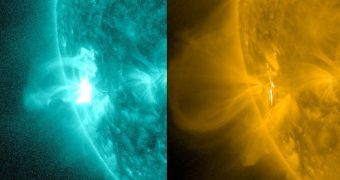Researchers at the George Mason University (GMU) have produced the evidence the international astronomical community lacked for confirming the existence of magnetic ropes. These solar processes are believed to be the progenitors of solar storms.
The investigation was conducted by GMU School of Physics, Astronomy and Computational Sciences associate professor Jie Zhang, who also holds an appointment at the university's Space Weather Lab. Graduate student Xin Cheng was also a member of the research team.
Details of the work were made public during the meeting the American Astronomical Society Solar Physics Division held in Las Cruces, Mexico earlier this month. The team describes a magnetic rope as a group of magnetic field lines that connect around a central axis,
As this happens, the theory goes, the lines may even twist around each other. If that were to happen, then the result would be an electrical current capable of generating an electromagnetic force capable of suppressing the magnetic field lines that usually prevent solar flares.
Theorists say that the magnetic ropes would then shoot our of the star at amazing velocities. Until the new study, experts were never able to identify such events, and so the proposal remained just an idea.
By using data collected by the Atmospheric Imaging Assembly (AIA) instrument aboard the NASA Solar Dynamics Observatory (SDO), the team was able to observe limited portions of the Sun in the moments before a solar flare occurred.
AIA datasets revealed the existence of a massive, low-lying hot filament on the surface of the Sun just before the solar storm was triggered. Observations showed that temperatures reached as much as 10 million degrees, and rising.
Once a certain threshold was reached, the hot channel burst to form a feature unlike anything experts have ever seen before. What Zhang and Cheng are proposing is that the mysterious feature was the theoretical magnetic rope.
“The magnetic rope triggers a solar eruption. Scientists have been debating whether or not this magnetic rope exists before a solar eruption. I believe that the result of this excellent observation helps finally solve this controversial issue,” Zhang says, quoted by Universe Today.
“Understanding the eruption process of these storms will definitely help us better predict them. We cannot prevent solar storms, just like we cannot prevent earthquakes or volcanoes,” the expert adds.
“But the development of prediction capacity can help mitigate adverse effects. For instance, satellite operators can power-down key systems to prevent the possible damage to the systems,” he concludes.

 14 DAY TRIAL //
14 DAY TRIAL //